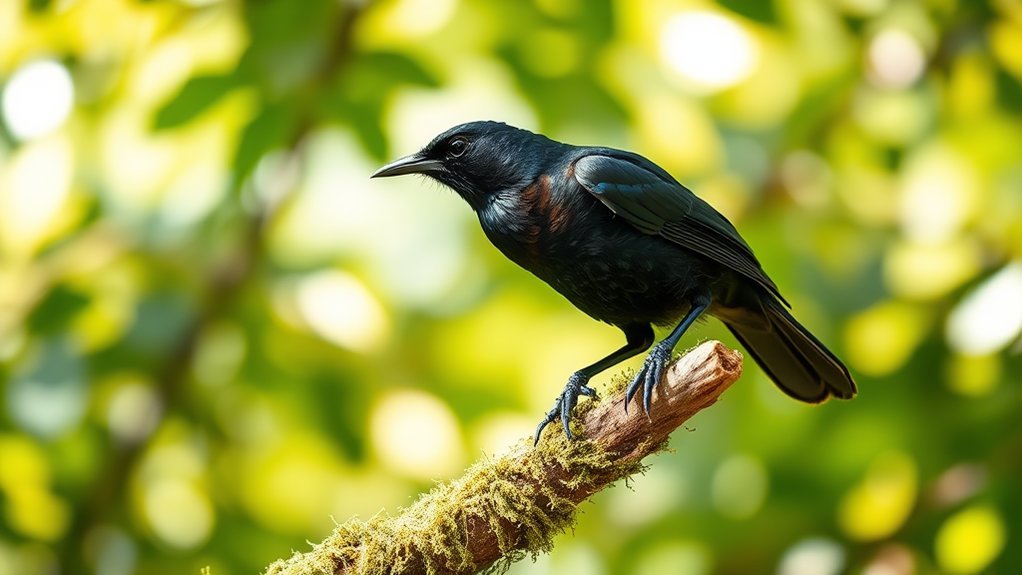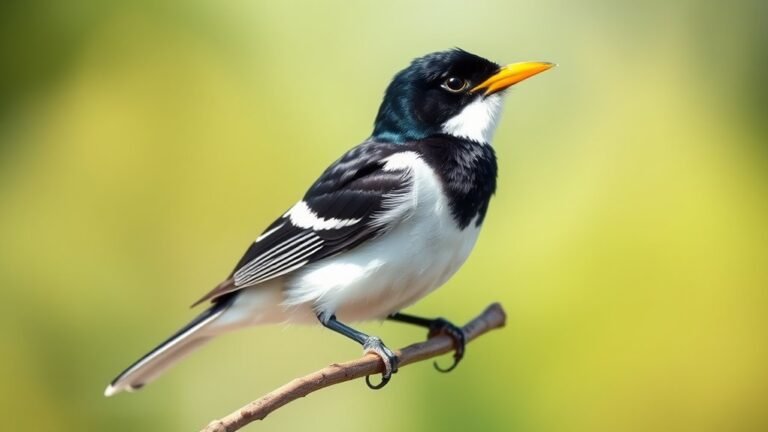Black Bird With Brown Chest: Identification Made Easy
To identify a black bird with a brown chest, observe its plumage sheen and patterns. Two species often confused are the Brown-headed Cowbird and the Common Grackle. Despite similar colors, their habitats and behaviors differ. By carefully watching these birds in their environments, you can distinguish between them. What details will you notice next?
Key Takeaways
- Common Grackle: This bird has iridescent black feathers and a brown chest. You will often find it in cities near wetlands.
- Red-winged Blackbird: Look for a black body with bright yellow shoulder patches. This bird usually lives in marshes and areas with cattails.
- Brown-headed Cowbird: This bird has shiny black feathers and a unique brown cap. It prefers open woodlands and grasslands.
- Seasonal Changes: Male blackbirds have brighter colors in spring. Notice the differences in their plumage throughout the year for identification.
- Observation Techniques: Use binoculars to see them better. Watch for their feeding and nesting behaviors. Listen for their distinct calls to help recognize them.
Understanding Bird Coloration and Markings
When you watch birds, their colors and markings have important functions. They can show the species, age, and health of the bird. Analyzing color patterns can reveal details about a bird's life. Bright plumage often means the bird is ready to mate, while dull colors can help it hide during nesting.
The texture of feathers also matters. The state of a bird's feathers can show how healthy it is. Healthy feathers suggest good nutrition and adaptation to its environment. In contrast, damaged feathers may indicate stress or illness.
Common Species That Fit the Description
Several bird species have a black body with a brown chest. One example is the Brown-headed Cowbird. This bird has shiny black feathers and a unique brown cap.
Another example is the Common Grackle. This bird displays iridescent black feathers with a brown breast that shines in the light.
The Red-winged Blackbird also matches this description, featuring bright yellow shoulder patches that stand out against its black body and brown underparts.
Observing these birds helps you appreciate their beauty and adaptability. Their distinct colors and patterns add variety to their habitats, enriching our experience of nature.
Identifying these birds can foster a deeper connection to the environment, making birdwatching a rewarding activity.
Habitat and Geographical Range
The Brown-headed Cowbird, Common Grackle, and Red-winged Blackbird have different habitats and geographical ranges.
The Brown-headed Cowbird prefers open woodlands and grasslands, often nesting in agricultural areas. The Common Grackle thrives in urban and suburban areas, favoring wetland edges and open fields.
In contrast, the Red-winged Blackbird occupies marshes and cattail stands, establishing territories near water.
Migration patterns also differ among these species. The Brown-headed Cowbird migrates south in winter.
Understanding these differences helps birdwatchers and nature lovers appreciate the unique habitats and adaptations of these birds.
The Role of Seasonal Changes in Identification
Seasonal changes have a significant impact on identifying blackbirds, such as the Brown-headed Cowbird, Common Grackle, and Red-winged Blackbird. Their migration patterns affect when and where you can see them.
In spring, male blackbirds often display bright colors. For instance, the Red-winged Blackbird has noticeable red and yellow markings on its shoulders. During winter, their colors become more muted, making identification harder.
Take note of each bird's size, bill shape, and behavior throughout the year. Understanding these seasonal differences will help you identify blackbirds in various environments.
This knowledge also deepens your connection to the bird community around you. Enjoy the process of observing and learning about these fascinating birds.
Observational Techniques for Birdwatching
To identify blackbirds effectively, you should use several simple observational techniques. Follow these strategies for better results:
- Choose a Good Spot: Find a stable place where you can watch without moving too much. This will help you to avoid disturbing the birds.
- Watch Their Actions: Pay attention to how they feed and nest. Their behaviors can help you figure out which species you're observing.
- Listen to Their Calls: Different species make unique sounds. Noting their vocalizations can assist in distinguishing between them.
- Use Tools: Binoculars or spotting scopes will allow you to see details like their plumage and markings clearly.
These techniques will help you enjoy birdwatching while respecting the birds and their homes.
Resources and Tools for Bird Identification
To start identifying birds, gather the right resources and tools. Use reliable field guides for your area. These guides provide clear descriptions, illustrations, and notes on bird behavior.
Also, download bird identification apps. They connect you to large databases and can determine your location for accurate results. Many apps allow photo sharing, which helps you compare your sightings with others.
A good pair of binoculars is essential. They enable you to observe birds closely from a distance.
Join online birdwatching forums to connect with other enthusiasts. Sharing insights and experiences enhances your learning and makes the journey more enjoyable.
With these tools, you can explore birdwatching more effectively and share your passion with others.
Sharing Your Sightings and Connecting With Others
Sharing your birdwatching experiences with others helps you learn and strengthens the community's knowledge. Here are some simple ways to share:
- Photo Sharing: Take pictures of birds and upload them online. Including details in your captions helps others identify the birds correctly.
- Sighting Logs: Keep a record of your bird sightings. Note the date, location, and behaviors you observe. This information supports broader research efforts.
- Join Local Clubs: Connect with birdwatching groups in your area. Share your findings and learn from others by attending workshops and meetings.
- Social Media: Use specific hashtags to find and meet other birdwatchers. Share your experiences and join conversations online.
Sharing your experiences can be fun and rewarding. It builds friendships and deepens your understanding of birds.
Happy birdwatching!
Frequently Asked Questions
What Is the Best Time of Year to Spot These Birds?
The best time to spot these birds is in spring. During this season, their behaviors become clearer. This makes it easier to see their unique traits and interactions with their surroundings.
How Can I Differentiate Juveniles From Adults?
To differentiate juveniles from adults, observe the plumage. Juvenile plumage is usually duller and less defined than adult plumage. Also, note the vocalizations; adults have distinct patterns in their calls. These characteristics help you identify their developmental stages clearly in nature.
Are There Any Notable Behaviors to Observe?
When observing these birds, look for their courtship displays during mating. Pay attention to how they feed, as they often search for food in pairs. This behavior highlights their social structures and helps you understand their ecology better.
What Equipment Is Best for Close-Up Observations?
For close-up observations, use high-magnification binoculars that gather light well. Choose telescopes with adjustable focus and sturdy mounts for better stability. These features ensure clear viewing as you observe interesting bird behaviors. Enjoy the details and beauty of nature with the right equipment.
Do These Birds Migrate or Stay Year-Round?
Bird migration depends on their breeding habits and habitats. Some birds stay in suitable areas all year. Others migrate to find better nesting sites and food. This shows how birds adapt to changes in their environment.

Kashvi is a passionate bird enthusiast and nature lover who has been fascinated by the world of birds for years. With a keen eye for detail and a love for learning, Kashvi is dedicated to sharing her knowledge and insights with fellow bird enthusiasts on Avian Enthusiasts. Through her engaging and informative articles, Kashvi aims to inspire others to join her in exploring the fascinating world of birds and to promote a deeper appreciation for these incredible creatures.







